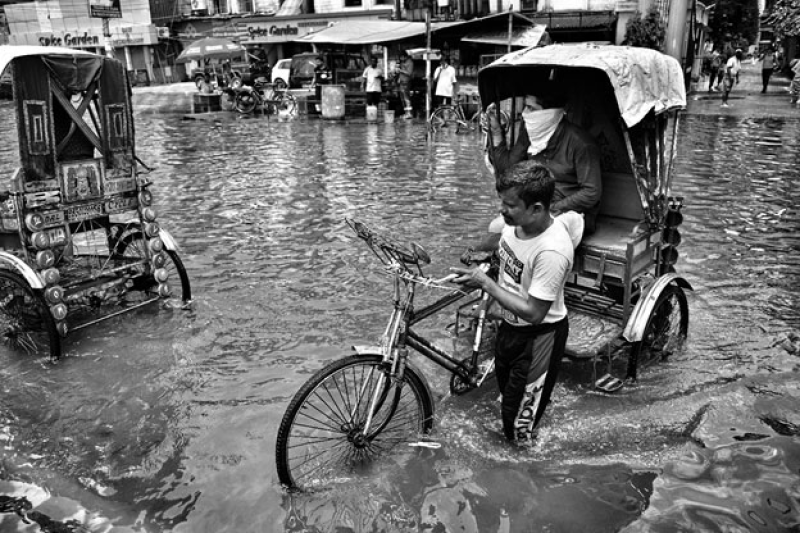- Dhaka stocks rebound after five-day losing streak |
- Cox’s Bazar Airport Upgraded to International Status |
- With $80 per capita Bangladesh is getting trappeded in climate debt |
- Dhaka’s air recorded ‘unhealthy’ Monday morning |
- CA Urges IFAD to Launch Social Business Fund for Agri Youth |
AI Tools Guide Smarter Disaster Risk Reduction Investments

A tricycle rider was wading through a flooded area in Kolkata, India.
The theme of this year’s International Day for Disaster Risk Reduction, “Fund Resilience, Not Disasters,” highlighted the urgent need to shift from reactive spending on recovery to proactive investment in disaster risk reduction.
Advances in satellite imagery analysis and artificial intelligence (AI) now allow hazards, exposures, and vulnerabilities to be mapped more effectively, providing timely and clear insights into who and what is at risk, and guiding more targeted investments in resilience and disaster preparedness. Leveraging these advances is essential to building resilience and safeguarding lives and livelihoods in Asia and the Pacific—the world’s most disaster-prone region.
Building on big Earth data, cloud computing, and AI, a new tool—SatGPT—offers an innovative solution for flood risk mapping. Developed by UN ESCAP in collaboration with regional technical and institutional partners, SatGPT is a next-generation spatial decision support system designed for rapid deployment, particularly useful in flood-prone and resource-limited contexts.
By mapping historical hotspots and past flood events using archived satellite imagery, SatGPT helps allocate disaster risk reduction investments where they are needed most, reducing both human and economic losses. It contributes to the implementation of the four pillars of the Early Warnings for All Initiative by enhancing disaster risk knowledge and providing historical flooding data.
SatGPT can also improve forecasting models, strengthen early warning analysis, and inform preparedness and response strategies. These technological advancements deliver consistent, accessible, comparable, and open-source risk information, enabling evidence-based disaster risk reduction decisions.
Country-specific initiatives demonstrate the value of Earth observation data and digital innovations. The Philippine Space Agency’s Integrated Network for Space-Enabled Actions towards Sustainability (PINAS) connects citizens, public, and private sectors to improve disaster response and sustainable development.
Indonesia is developing an AI-driven flood mapping project with pilot sites in Jakarta and North Java, with plans to integrate SatGPT into this platform. Thailand’s Check Nahm (Check Flood) application consolidates data from CCTV and other sources to enhance early warning systems, providing near real-time flood updates and forecasts. SatGPT’s historical mapping capabilities can be incorporated into the platform.
The University of Hong Kong highlights how flooding exacerbates social inequalities by integrating geospatial, AI, and socioeconomic data. Vulnerability analysis shows that people with weaker socioeconomic status face higher exposure and greater impacts.
The Jakarta Ministerial Declaration on Space Applications for Sustainable Development emphasized the potential of emerging technologies from the Fourth Industrial Revolution to advance the Sustainable Development Goals. To translate this into tangible impacts, countries are equipping young government professionals with skills to analyze trends and convert geospatial information into actionable insights using SatGPT and other AI-powered tools, driving smarter and faster disaster risk reduction decisions.
Future efforts will focus on enhanced AI development, access to open-source data, standardized methodologies, and capacity development. Strengthening local governments’ and communities’ ability to apply AI-powered tools like SatGPT will generate localized insights on high-risk areas, making mitigation and adaptation investments more effective.
As we champion funding for resilience and co-develop AI-powered disaster tools, it is vital to remember that data and technology are only meaningful when they protect real communities facing real risks. Keeping this human perspective central ensures efforts remain grounded in empathy, purpose, and impact.
Kareff Rafisura is Economic Affairs Officer, ESCAP; Sheryl Rose Reyes is Consultant, ESCAP; and Natdanai Punsin is Geo-Informatics Officer, GISTDA

